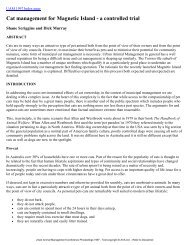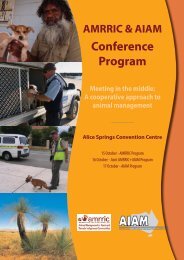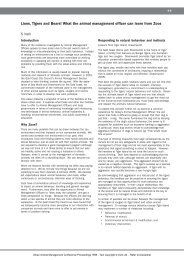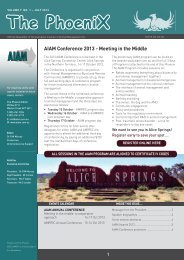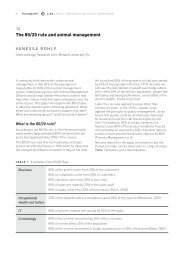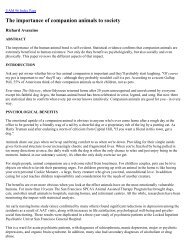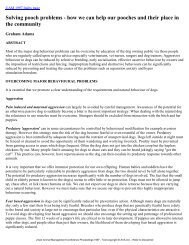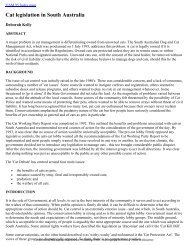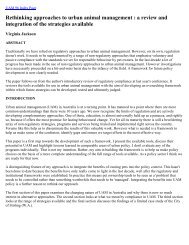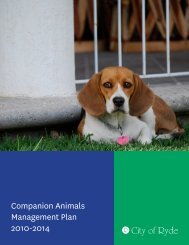Proceedings OF ThE - Australian Institute of Animal Management Inc
Proceedings OF ThE - Australian Institute of Animal Management Inc
Proceedings OF ThE - Australian Institute of Animal Management Inc
Create successful ePaper yourself
Turn your PDF publications into a flip-book with our unique Google optimized e-Paper software.
Annual Conference on <strong>Animal</strong> <strong>Management</strong> AIAM <strong>Proceedings</strong> 2012 79<br />
11. <strong>Animal</strong> management goal<br />
In a very strategic context, the Strategic <strong>Animal</strong><br />
<strong>Management</strong> Plan should be supported by two<br />
or three statements that clearly articulate the<br />
development <strong>of</strong> the plan, and its long term<br />
aspirations. For example:<br />
“This animal management strategy has been developed<br />
with a common sense <strong>of</strong> purpose, mutual assistance,<br />
progressive ideas, aspirations, knowledge sharing and<br />
experience on important matters pertaining to the<br />
delivery <strong>of</strong> sustainable animal management practices<br />
and policies across the region”.<br />
12. Key PArtnersHIPs and<br />
stakeholders<br />
Plans cannot be developed in isolation; their<br />
sustainability relies heavily on the assistance <strong>of</strong> key<br />
partners and stakeholders. These groups should be<br />
acknowledged for their contribution and participation<br />
in the process. An example <strong>of</strong> the type <strong>of</strong> key<br />
partners, stakeholders etc is given below.<br />
Key partners:<br />
• yCommunity – groups/hubs/locals;<br />
• yIndustry Groups – business/service providers/<br />
contractors; and<br />
• ySpecial Interest Groups – breeders/welfare<br />
groups/clubs.<br />
External stakeholders:<br />
• yCommunity;<br />
• yRatepayers association;<br />
• yEnvironmental groups; and<br />
• yOther government agencies.<br />
Internal Stakeholders:<br />
• yElected Representatives;<br />
• yOther Business Units/Departments;<br />
• yLegal Provider; and<br />
• yStaff.<br />
13. Description <strong>of</strong> the ACtivities<br />
Although obvious to those writing the plan, the tasks<br />
involved in animal management are not always clear.<br />
For this reason, always make a point <strong>of</strong> documenting<br />
clearly what animal management activities are<br />
carried out by Council. For example:<br />
• yCommunity Education – include a short narrative<br />
detailing what this means<br />
• yCommunity Service Obligation Services (i.e.<br />
animal impounding, complaint resolution, patrols,<br />
livestock etc)<br />
• yPound Services (i.e. holding, releasing and<br />
disposal)<br />
• yEnforcement (i.e. Notices, Infringements,<br />
Prosecution, Dispute Resolution etc)<br />
• yInformation Access (i.e. brochures, flyers,<br />
equipment etc)<br />
• yPlanning process (i.e. Strategic, Business,<br />
Operational, Reporting, Policy etc)<br />
• yPartnerships/Relationships/Collaboration,<br />
Consultation, Advocacy etc<br />
• yRecruitment, Training, Mentoring, Continuing<br />
Education, Information Repository/Library etc<br />
• yService Standards (i.e. Service Level Agreements,<br />
Community/Councillors/Staff, Reporting/<br />
Benchmarking, Surveys, Audits and Reviews etc).<br />
14. Activity suMMAry<br />
For each activity provide a summary <strong>of</strong> funding and<br />
expenditure, business drivers (refer to Appendix 2),<br />
and current levels <strong>of</strong> service. The more information<br />
included the better. However, sourcing and recording<br />
data for more than a four year period can be onerous<br />
and time consuming. For this reason, gather what<br />
ever is available and make use <strong>of</strong> the content by<br />
using charts, tables and drawings to reduce the<br />
amount <strong>of</strong> text.<br />
15. Organisational structure<br />
Detail your organisational structure, the framework<br />
and the hierarchy within which your Council<br />
arranges its lines <strong>of</strong> authority and communications,<br />
and allocates rights and duties. An organisational<br />
flowchart can normally be sourced from Human<br />
Resources and generally suffices for this purpose.<br />
16. Roles and responsibilities<br />
In order to effectively engage and create a better<br />
appreciation <strong>of</strong> Council and animal management<br />
services, it is important to provide the audience<br />
with a clear definition and understanding <strong>of</strong> the<br />
role, functions, and responsibilities <strong>of</strong> the animal<br />
management team. Providing this information will<br />
assist readers with understanding the tasks, issues,<br />
and limitations <strong>of</strong> local government, in the very<br />
complex business <strong>of</strong> animal management.



